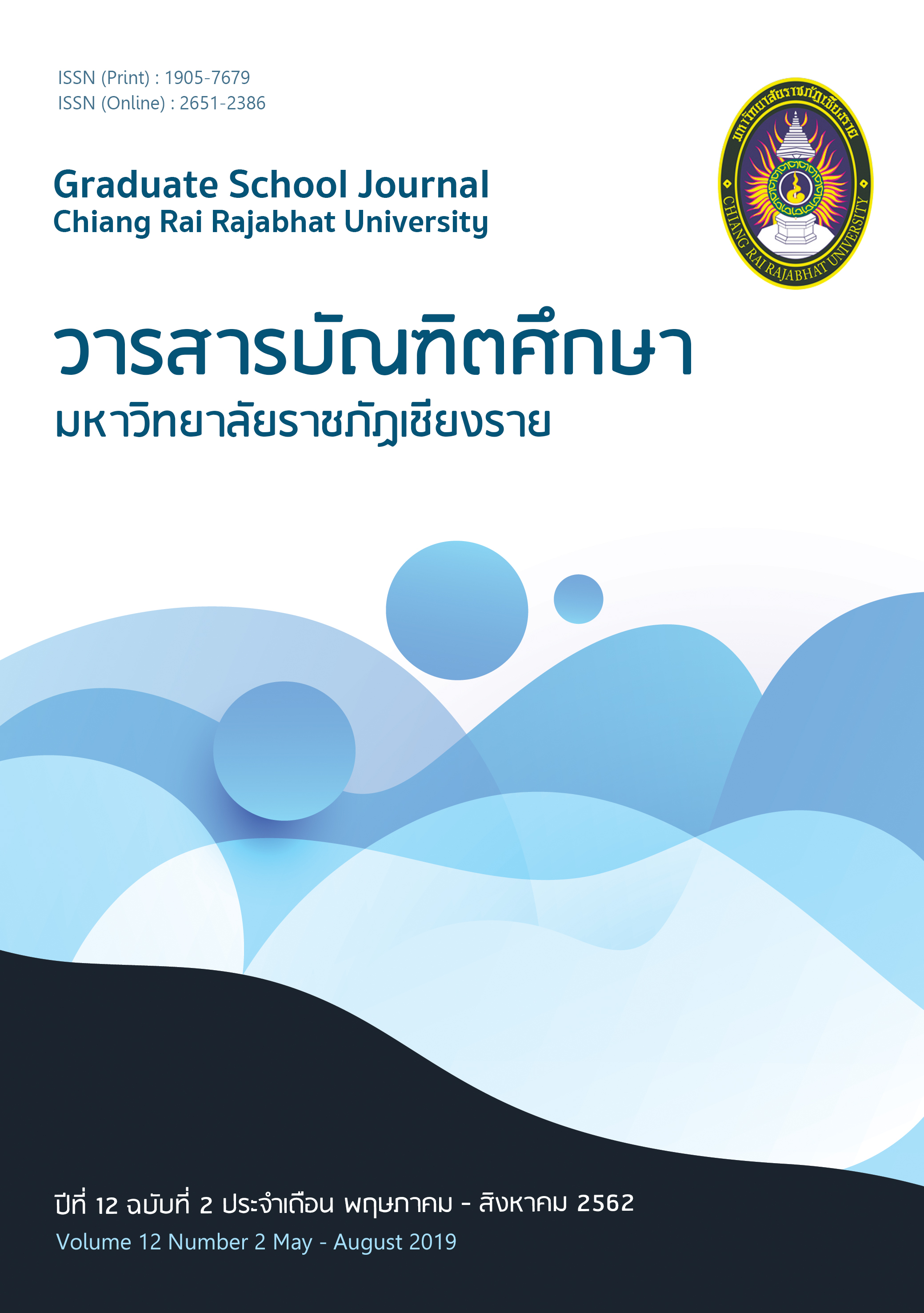การบริโภคสินค้าและอาหารอินทรีย์ของประชาชนในเขตอำเภอสันทราย จังหวัดเชียงใหม่
Main Article Content
บทคัดย่อ
การวิจัยนี้เป็นการวิจัยเชิงปริมาณมีวัตถุประสงค์เพื่อ 1) ศึกษาพฤติกรรมการบริโภคสินค้าและอาหารอินทรีย์ของประชาชนในเขตอำเภอสันทราย จังหวัดเชียงใหม่ และ 2) เพื่อศึกษาปัจจัยส่วนประสมทางการตลาดที่ส่งผลต่อการบริโภคสินค้าและอาหารอินทรีย์ของประชาชนในเขตอำเภอสันทราย จังหวัดเชียงใหม่ กลุ่มตัวอย่างที่ใช้ในการวิจัย คือ กลุ่มประชาชนที่อาศัยอยู่ในพื้นที่อำเภอสันทราย จังหวัดเชียงใหม่ จำนวน 400 คน การวิเคราะห์ข้อมูลด้วยโปรแกรมประมวลผลข้อมูลสถิติสำเร็จรูป SPSS โดยใช้สถิติเชิงพรรณนาการวิเคราะห์ข้อมูลโดยใช้สถิติเชิงพรรณนา ได้แก่ ความถี่ ร้อยละ และค่าเฉลี่ย
ผลการศึกษา พบว่า ผู้ตอบแบบสอบถามส่วนใหญ่นิยมเลือกซื้อสินค้าและอาหารอินทรีย์ ประเภทผัก คือ ผักบุ้ง ประเภทผลไม้ คือ กล้วย และประเภทอื่น ๆ คือ เห็ดชนิดต่าง ๆ มีเหตุผลที่เลือกซื้อ คือ ห่วงใยสุขภาพ โดยสถานที่เลือกซื้อสินค้าและอาหารอินทรีย์ 3 อันดับแรก คือ ตลาดสด ร้านค้าในมหาวิทยาลัยแม่โจ้ และตลาดอินทรีย์ ตามลำดับ เหตุผลที่ซื้อจากสถานที่ดังกล่าวเพราะว่า มีคุณภาพเชื่อถือได้ มีค่าใช้จ่ายในแต่ละครั้งที่ซื้อสินค้าและอาหารอินทรีย์อยู่ระหว่าง 51 – 100 บาท นิยมซื้อสินค้าและอาหารอินทรีย์ในช่วงเวลา 15.00 – 18.00 น. มีความถี่ในการเลือกซื้อ จำนวน 2 – 3 ครั้ง ต่อสัปดาห์ โดยส่วนใหญ่จะตัดสินใจซื้อด้วยตนเอง สำหรับการศึกษาปัจจัยส่วนประสมทางการตลาดที่ส่งผลต่อการบริโภคสินค้าและอาหารอินทรีย์ พบว่า ส่วนใหญ่ให้ความสำคัญด้านผลิตภัณฑ์หรือการให้บริการ คือ ความปลอดภัยในการบริโภค ด้านราคา คือ ราคาขายเหมาะสมกับคุณภาพ ด้านช่องทางการจัดจำหน่าย คือ มีสถานที่จอดรถสะดวก ด้านการส่งเสริมการตลาด คือ การจัดทำโฆษณาผ่านสื่อต่าง ๆ ด้านบุคคลหรือพนักงาน คือ ด้านความสุภาพ มีมารยาท ซื่อสัตย์ จริงใจ ด้านการสร้างและนำเสนอลักษณะทางกายภาพ คือ สถานที่มีความสะอาด มีการรักษาสิ่งแวดล้อม ด้านกระบวนการ คือ ความถูกต้องในการคิดราคา
Article Details
บทความที่ได้รับการตีพิมพ์เป็นลิขสิทธิ์ของวารสารมหาวิทยาลัยราชภัฎเชียงราย
ข้อความที่ปรากฏในบทความแต่ละเรื่องในวารสารวิชาการเล่มนี้เป็นความคิดเห็นส่วนตัวของผู้เขียนแต่ละท่านไม่เกี่ยวข้องกับมหาวิทยาลัยราชภัฎเชียงราย และคณาจารย์ท่านอื่นๆในมหาวิทยาลัยฯ แต่อย่างใด ความรับผิดชอบองค์ประกอบทั้งหมดของบทความแต่ละเรื่องเป็นของผู้เขียนแต่ละท่าน หากมีความผิดพลาดใดๆ ผู้เขียนแต่ละท่านจะรับผิดชอบบทความของตนเองแต่ผู้เดียว
เอกสารอ้างอิง
ฐรินดา คล่องแคล้ว. (2552). พฤติกรรมและปัจจัยที่มีอิทธิพลต่อการตัดสินใจซื้อผักอินทรีย์ของผู้บริโภคที่ท็อปส์ซูเปอร์มาร์เก็ตในกรุงเทพมหานคร. (วิทยานิพนธ์วิทยาศาสตรมหาบัณฑิต). มหาวิทยาลัยเกษตรศาสตร์. กรุงเทพฯ.
ณัฐธีร์ ศิวเดชเจริญวงษ์. (2555). การตัดสินใจเลือกซื้อผักอินทรีย์จากร้านมูลนิธิโครงการหลวงในเขตกรุงเทพมหานคร. (วิทยานิพนธ์วิทยาศาสตรมหาบัณฑิต). มหาวิทยาลัยเกษตรศาสตร์. กรุงเทพฯ.
ธิดารัตน์ มณีกาศ. (2553). ปัจจัยกำหนดความต้องการซื้อสินค้าเกษตรอินทรีย์. (วิทยานิพนธ์เศรษฐศาสตรมหาบัณฑิต). มหาวิทยาลัยรามคำแหง. กรุงเทพฯ.
ภานุวัฒน์ ก้อนทรัพย์. (2551). ความต้องการของผู้บริโภคในการเลือกซื้อผลิตภัณฑ์เกษตรอินทรีย์ของเครือข่ายกาดนัดผู้ผลิตเกษตรอินทรีย์จังหวัดเชียงใหม่. (วิทยานิพนธ์บริหารธุรกิจมหาบัณฑิต). มหาวิทยาลัยแม่โจ้. เชียงใหม่.
ภูษณิศา เตชเถกิง และ ปรีดา ศรีนฤวรรณ. (2552). ความต้องการและพฤติกรรมของผู้บริโภคผลิตภัณฑ์เกษตรอินทรีย์ของวิสาหกิจชุมชนในจังหวัดเชียงใหม่. เชียงใหม่: มหาวิทยาลัยแม่โจ้.
วิกิพีเดีย สารานุกรมเสรี. (2561). อำเภอสันทราย. สืบค้นเมื่อ 10 ตุลาคม 2561, จาก http://www.th.wikipedia.org/wiki/อำเภอสันทราย
ศูนย์วิจัยกสิกรไทย. (2554). การเติบโตของตลาดเกษตรอินทรีย์ในตลาดอาเซียน AEC. สืบค้นเมื่อ 29 มีนาคม 2558, จาก http://www.ksmecare.com/Article/64/25171/การเติบโตของตลาดเกษตรอินทรีย์ในตลาดอาเซียน-AEC
สำนักงานคณะกรรมการนโยบายวิทยาศาสตร์ เทคโนโลยีและนวัตกรรมแห่งชาติ. (2557). โครงการเสวนารวมพลคนเกษตรอินทรีย์ไทย : ใคร ทำอะไร ที่ไหน อย่างไร. สืบค้นเมื่อ 29 มีนาคม 2558, จาก http://www.ietc.mju.ac.th/wtms_newsDetail.aspx?nID=12792
สำนักงานที่ปรึกษาด้านอุตสาหกรรมในต่างประเทศ ประจำกรุงเวียนนา ประเทศออสเตรีย. (2558). รายงานสถิติ แนวโน้มและทิศทางเกษตรอินทรีย์ 2015. สืบค้นเมื่อ 8 มีนาคม 2558, จาก https://www.thaiin dustrialoffice.wordpress.com/2015/02/24/รายงานสถิติ แนวโน้มและทิศทางเกษตรอินทรีย์ 2015


